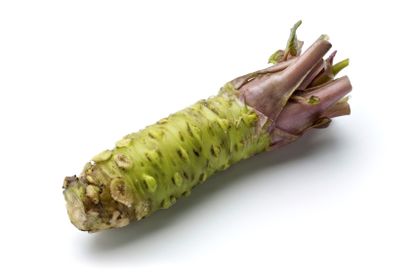About Wasabi Plants: Can You Grow A Wasabi Vegetable Root

If you love sushi, then you are relatively familiar with the green paste provided as a condiment alongside the dish-- wasabi. You may have wondered what this green stuff with a major kick really is and where it comes from. Let's learn more about wasabi uses.
What is Wasabi?
The hot, delicious green paste is derived from the wasabi vegetable root. Wasabi vegetable root is a member of the Brassicaceae family, which includes cabbage, mustard, and horseradish. In fact, wasabi is often referred to as Japanese horseradish. Wasabi plants are native perennials found along stream beds in mountain river valleys in Japan. There are several varieties of wasabi and amongst them are:
- Wasabia japonica
- Cochlearia wasabi
- Wasabi koreana
- Wasabi tetsuigi
- Eutrema japonica
The cultivation of wasabi rhizomes dates to at least the 10th century.
Growing Wasabi Plants
Wasabi grows best in loose, organic-rich soil that is somewhat moist. It also prefers a soil pH between 6 and 7. As for location, this is one of those veggies that you can actually place in a shady area of the garden, or even near a pond. Prior to planting, it is advised to soak the roots in cool water and remove any damaged leaves. Plant wasabi in spring once outdoor temps are about 50 to 60 degrees F. (10-16 C.) and space plants about 12 inches (31 cm.) apart. Wasabi may also be planted in containers, using a 6 inch (15 cm.) pot filled with organic-rich potting mix and then transplanting after a year to a 12 inch (31 cm.) pot. To increase drainage, put sand in the bottom of the pot. Water wasabi plants thoroughly and frequently. Mulching around the plants will help retain soil moisture. Prune back any wilted or unsightly leaves or stems on the plant. Control weeds throughout the growing season and check for pests such slugs and snails. A slow release 12-12-12 fertilizer applied every three to four months is generally recommended when growing wasabi plants. Fertilizers high in sulfur are said to increase their flavor and spiciness. Harvest the roots in the spring or autumn when temperatures are cool. Keep in mind that it normally takes about two years for the rhizomes to mature or reach 4 to 6 inches (10-15 cm.) in length. When harvesting wasabi, pull up the entire plant, removing any side shoots. Wasabi needs to be protected from cold winter temperatures. In warmer areas, a generous application of mulch is sufficient. Those in colder regions, however, should grow wasabi in pots that can be moved to a sheltered location.
Wasabi Uses
Although the foliage of wasabi plants can be eaten fresh and are sometimes dried for use in other processed foods or pickled in sake brine or soy sauce, the root is the prize. The heat from the wasabi rhizome is unlike the capsaicin found in chili peppers. Wasabi stimulates the nasal passages more than the tongue, initially feeling fiery, and rapidly dissipating to a sweeter flavor without a burning sensation. The fiery properties of wasabi are not oil-based like that in hot peppers, so the effect is relatively short and can be assuaged with other foods or liquids. Some of wasabi's uses are, of course, as a condiment with sushi or sashimi but it is also delicious in noodle soups, as a condiment for grilled meats and veggies, or added to dips, marinades, and salad dressings. When using fresh wasabi root, it is often grated just prior to eating, as it loses flavor within the first few hours. Or it is kept covered and, for sushi presentation, sandwiched between the fish and the rice. Much of the green paste or powder we know as wasabi is, in fact, not wasabi root at all. Since wasabi plants require particular conditions for cultivation, the root is fairly pricey and the average gardener may have difficulty growing it. Therefore, a combination of mustard powder or horseradish, cornstarch, and artificial coloring is often substituted for the real thing.
How to Prepare Wasabi Root
First, select an unblemished, firm root, wash it, and then peel it with a knife. Grinding the root finely into a thick paste is the key to releasing the sharp flavor of wasabi. Japanese chefs use sharkskin to achieve this thick paste, but you can use the smallest holes on a metal grater, grating with a circular motion. Cover the resultant paste with plastic wrap, let sit for 10 to 15 minutes prior to use to develop flavor and then utilize within the next few hours. Any leftover root should be covered with damp towels and refrigerated. Rinse the root in cool water every couple of days and check for any decay. A refrigerated wasabi rhizome will last about one month.
Gardening tips, videos, info and more delivered right to your inbox!
Sign up for the Gardening Know How newsletter today and receive a free download of our DIY eBook "Bring Your Garden Indoors: 13 DIY Projects For Fall And Winter".

Amy Grant has been gardening for 30 years and writing for 15. A professional chef and caterer, Amy's area of expertise is culinary gardening.
-
 10 Fabulous Flower Festivals To Visit – Enjoy The Ultimate Inspiration For Your Garden
10 Fabulous Flower Festivals To Visit – Enjoy The Ultimate Inspiration For Your GardenStuck for garden inspiration and looking for more ideas on making your backyard notions a reality? Here are 10 flower festivals to help you unlock your growing potential
By Bonnie L. Grant
-
 Composting Paper: A Complete Guide To Transforming Different Types Into Garden Gold
Composting Paper: A Complete Guide To Transforming Different Types Into Garden GoldReduce waste and learn the secrets of composting paper at home with our guide to demystifying which types can enrich your garden – and which to avoid.
By Amy Grant